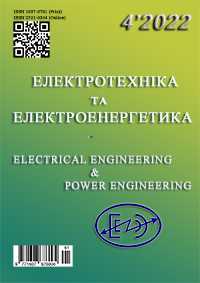The system for electric vehicle slippage prevention based on a fuzzy logic controller
DOI:
https://doi.org/10.15588/1607-6761-2022-4-1Keywords:
electric drive, electric vehicle, asynchronous motor, computer model, mechanical differential, fuzzy controllerAbstract
Purpose. Development of a functional diagram of a slip prevention system, build a mathematical model, synthesize a fuzzy regulator, simulate and confirm the system's performance.
Methodology. Mathematical analysis and modeling.
Findings. The structure is substantiated and the linguistic variables of the fuzzy regulator are determined. The choice of the number of terms of the input and output variables of the fuzzy controller is made, proceeding from the minimization of the number of logical processing rules. The terms of the linguistic variables of the fuzzy controller are selected in the form of the simplest triangular for the mean values of the range of their definition and trapezoidal for the limit values. Logical processing rules were developed. The choice of the fuzzy inference algorithm was made and the defuzzification parameters were determined. A computer model of the slip prevention system was built using the Fuzzy logic toolbox of the MATLAB package and was framed using 9 logic processing rules. Computer simulation of the acceleration of an electric vehicle with subsequent slipping by one and two wheels has been carried out. The system maintains the inconsistency of wheel speeds with the electric vehicle speed at a constant set level of 1.5s-1 - in accordance with the formulated identification algorithm and completely prevents excessive slipping.
Originality. The built-in phase regulator ensures minimization of the discrepancy between the speed of the wheel rotation and the linear speed of the electric vehicle, which in turn minimizes slippage and provides the maximum possible torque relative to the moment of installation.
Practical value. Computer simulation was carried out for two modes: acceleration with a collision with a surface with a reduced coefficient of adhesion (0.1) with one wheel and acceleration with a collision with a surface with a reduced coefficient of adhesion (0.1) with two wheels. The system completely prevents excessive slipping.
References
Doklad o sostoyianyy bezopasnosty dorozhnoho dvyzhenia v myre. Access mode: https://apps.who.int/iris/bitstream/handle/10665/44122/9789244563847_rus.pdf;jsessionid=78E49896549A16CCA4A3C4EA29FD8042?sequence=2
Ang K.H., Chong G., Li Y. PID control system analysis, design, and technology. IEEE Transactions on Con-trol Systems Technology. 2005. – Vol. 13. – № 4. – P. 559–576. DOI: 10.1109/TCST.2005.847331
Quevedo J., Escobet T. Digital control: past, present and future of PID control. Proc. IFAC Workshop. Terrassa, Spain, 2000.
Ziegler J.G., Nichols N.B. Optimum settings for auto-matic controllers. Trans. ASME. 1942. V. 64. P. 759–768.
A. Gad and M. Farooq. Application of fuzzy logic in engineering problems. Proc. IECON. 2001. P. 2044-2049.
Rajamani, R., Piyabongkarn, N., Lew, J., Yi, K., Phan-omchoeng, G. Tire-Road Friction-Coefficient Estima-tion. IEEE. 2010, DOI: 10.1109/MCS.2010.937006
Vorobyov Bogdan, Pshenychnykov Dmytro. Modeling of the Operation of an Asynchronous Electric Drive of an Electric Vehicle in Slip Modes. 25th IEEE Inter-national conference on Problems of Automated Elec-tric Drive. Theory and Practice, PAEP 2020.
C. Carlos. Modeling, vector control and DTC: control of asynchronous machines. Hermes Science, Europe Ltd. 2000.
Bolee realistichny`e pokazateli potrebleniya topliva: novy`j standart ezdovogo czikla WLTP zamenit dejstvuyushhij NEDC. Режим доступу: https://www.audi.ru/ru/web/ru/innovations/wltp-lp.html
Klepikov V. B., Semikov A. V. i dr. Iz opyita soz-daniya elektroprivoda elektromobilya s super-kondensatornyim nakopitelem energii [From the ex-perience of creating electric drive electric vehicle with a super capacitor energy storage]. Visnyk Natsional-noho tekhnichnoho universytetu «KhPI». [Bulletin of the National Technical University “KhPI”]. Kharkiv: NTU «KhPI» 2015, Vyp. 112 (1121). Р. 195–198.
Bose, B. K., Modern Power Electronics and AC Drives, Prentice-Hall, N.J., 2002. Р. 558.
Downloads
Published
How to Cite
Issue
Section
License
Copyright (c) 2023 Bohdan Vorobiov, Serhii Senchenko, Dmytro Pshenychnykov, Yaroslav Likhno, Liu Khan

This work is licensed under a Creative Commons Attribution-ShareAlike 4.0 International License.
Creative Commons Licensing Notifications in the Copyright Notices
Authors who publish with this journal agree to the following terms:
Authors retain copyright and grant the journal right of first publication with the work simultaneously licensed under aCreative Commons Attribution License that allows others to share the work with an acknowledgement of the work's authorship and initial publication in this journal.
Authors are able to enter into separate, additional contractual arrangements for the non-exclusive distribution of the journal's published version of the work (e.g., post it to an institutional repository or publish it in a book), with an acknowledgement of its initial publication in this journal.
Authors are permitted and encouraged to post their work online (e.g., in institutional repositories or on their website) prior to and during the submission process, as it can lead to productive exchanges, as well as earlier and greater citation of published work.

